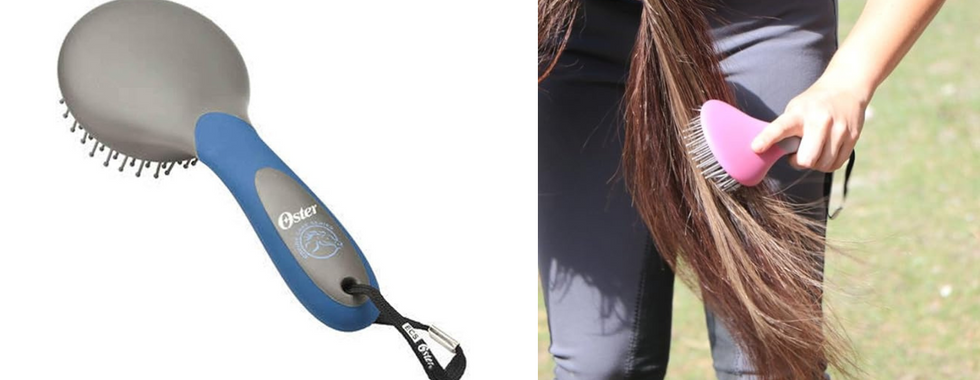Essential Horse Care Routines: Grooming
- th equine
- Dec 10, 2023
- 4 min read
Updated: Apr 11, 2024
In the equine world, whether we are owners, riders, or equine professionals, it is our job to ensure the well-being of the animals we interact with. That’s why grooming is one of the first things you learn when you step into the equine world, as students are usually required to prepare their horse before and after riding classes. Whether your horses live in a stable or out in the open fields, this fundamental skill is one of the keys to guarantee their health and happiness. Grooming not only ensures their well-being but also creates a bond between horses and humans, as it mimics bonding behaviours horses have with each other in the herd.

Regular hoof maintenance, dental checks, and vaccinations are universal essentials, but tailoring grooming practices to fit their surroundings is also important. So, when planning your horse care routine, consider factors such as your horse’s living arrangement, the place where they live and the current season.
Are you ready? Let’s start!
Living in Stables vs. Fields: Tailoring Care Practices
Living in stables versus fields requires different levels of care. Stabled horses need more attention since their movement and self-grooming ability are limited, while horses living in fields have more opportunity to self-groom due to their larger space. But this doesn’t mean that we can just ignore the horses on the fields, these animals require frequent inspections to guarantee that everything is ok.

Grooming Rituals: Before and After Work
The grooming routine not only keeps your horse comfortable, but also strengthens the bond between you two and it gives them a lot of pleasure.
In general, stabled horses that don’t spend a part of their day in a paddock should be brushed daily to remove dead hair, stimulate natural grease production, keep the hair clean and shiny, and promote circulation and skin health. Yes, brushing your horse’s coat isn’t just about aesthetics.
Likewise, even if horses live in a paddock, they should be thoroughly brushed before engaging in any equine activities. Pay special attention to areas prone to sweat and friction, such as under the saddle and around the girth. This pre-work grooming routine not only has the benefits I’ve already mentioned but also allows you to inspect your horse more closely for any skin issues or injuries that may need attention.

There are four steps for a proper horse grooming routine:
1st step – Curry comb
This step releases the dead hair and skin and should be made in the direction of the hair or using circular movements.
Pay attention to the more bony regions (head, tips of the hips and limbs) and to the softer areas (throat and groins) as if you don’t do it carefully this brushing can be a little aggressive, especially with the metal combs. Also, some horses don’t like when you brush these areas and might even become less friendly.
2nd step – Dandy brush
This brush is used to remove the hair and dead skin released by the curry comb. The brushing should be made in long movements from the head to the tail and from top to bottom.
These brushes can be stiffer or softer, but in case you have more than one, always star by the stiffer one.
3rd step – Untangle the mane and tail
Use a comb or a mane brush to undo the knots and remove stuck objects from the mane and tail.
Always brush in sections and holding the top part of the hair! Contrary to a common belief the mane and tail have sensibility.
4th step – Finishing or polishing
This step starts with a soft body brush and a face brush to remove any remaining fine dust and can be finished with a net/microfibre/wool glove and sponge.
Not essential in the day-to-day routine.

While a basic bath is recommended after work, if the weather is cold or you don’t have access to a solarium, post-work grooming is equally vital. Sweat, dust, and grime can accumulate during exercise, and a proper brushing helps prevent skin irritation and infections, as well as colds. In this case, after allowing the horse to dry a little, focus on removing sweat marks and untangling the mane and tail. However, areas that tend to accumulate more sweat, like the girth and the in-between the legs, should always be washed with water. You can use a hose, or, in colder places or if you finish working the horse at night time, you can use a sponge. This is equally important for horses that live in boxes or in the paddock, as both conditions can make the horse susceptible to colds. The box can retain humidity and make it difficult for the horse to dry and in the exterior the animal will be exposed to the cold and wind.

In conclusion, there is always a reason for everything we do. Understanding essential horse care routines and tailoring them to your horse's unique needs and conditions not only promotes their health but also deepens the bond between you and your horse. Tailor your practices and observe how the bond between you and your horse grows.
See you next week,
Isabel & Stephan
Check out our suggestions for grooming tools
You can find these items in most of your equestrian stores, but if you prefer, you can click on the images to purchase.
In our opinion Oster has the absolute BEST mane and tail brushes, because if you brush the tails a little more rough (like you are not supposed to do), this brush almost doesn't brake the hair, besides it has a very good grip. The rest of the products from Oster are also good, but not like the mane and tail brush, we LOVE it!
For brushes, our favourite brand is HAAS, because not only they good quality, as they last in good condition forever.
We also really like the Kerbl metal curry comb and hoof pick, because the metal is super good quality and durable. You just have to select curry combs that the metal is a little more heavy, because the super thin ones get sharp with the use. With a lot of use, but they do get sharp.
















コメント